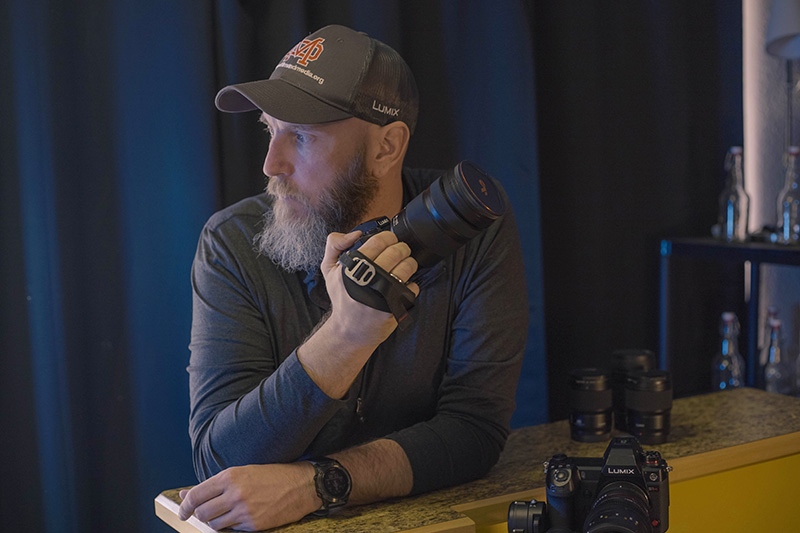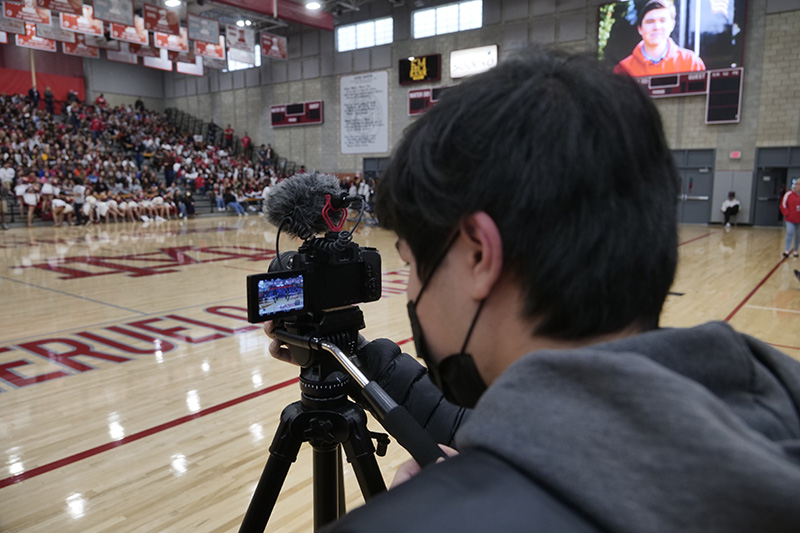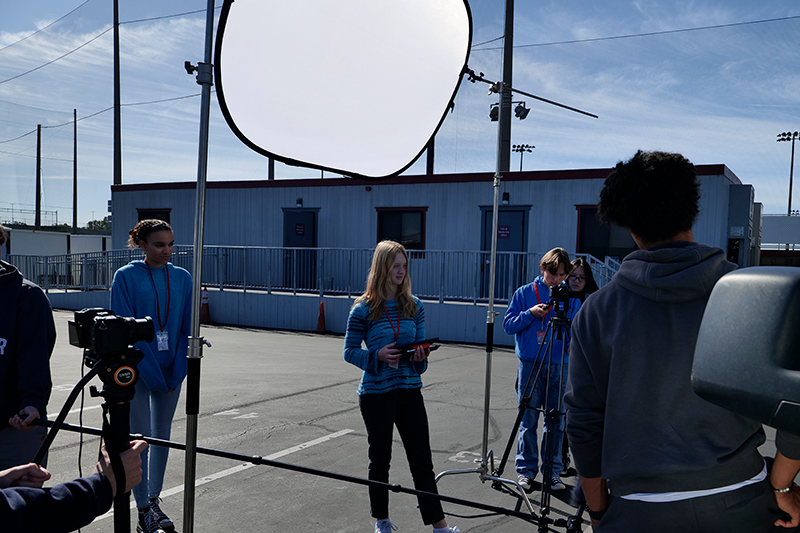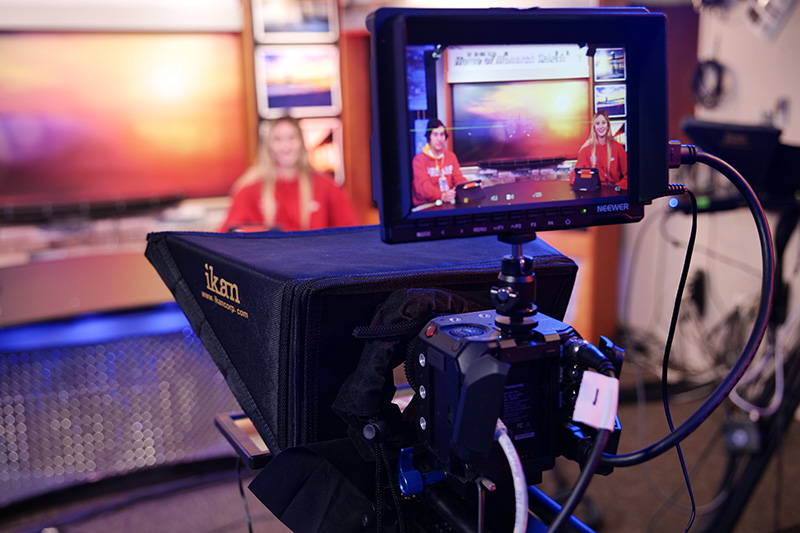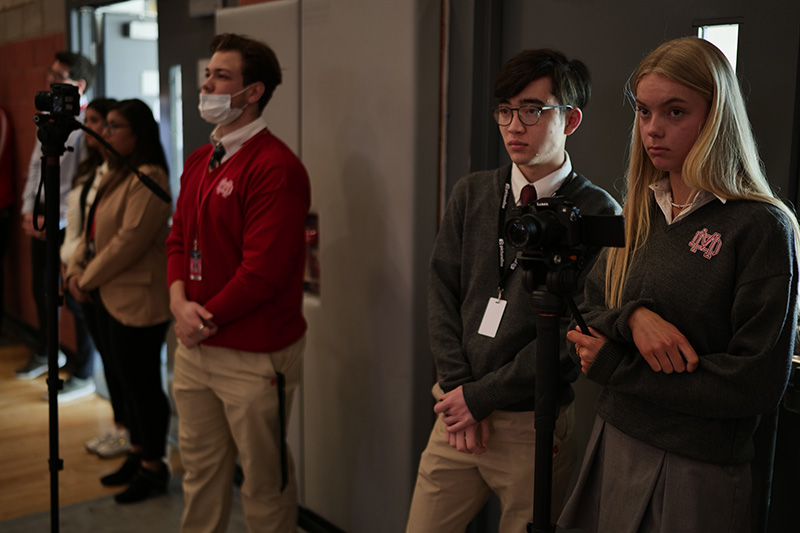Mater Dei Film & Media Program
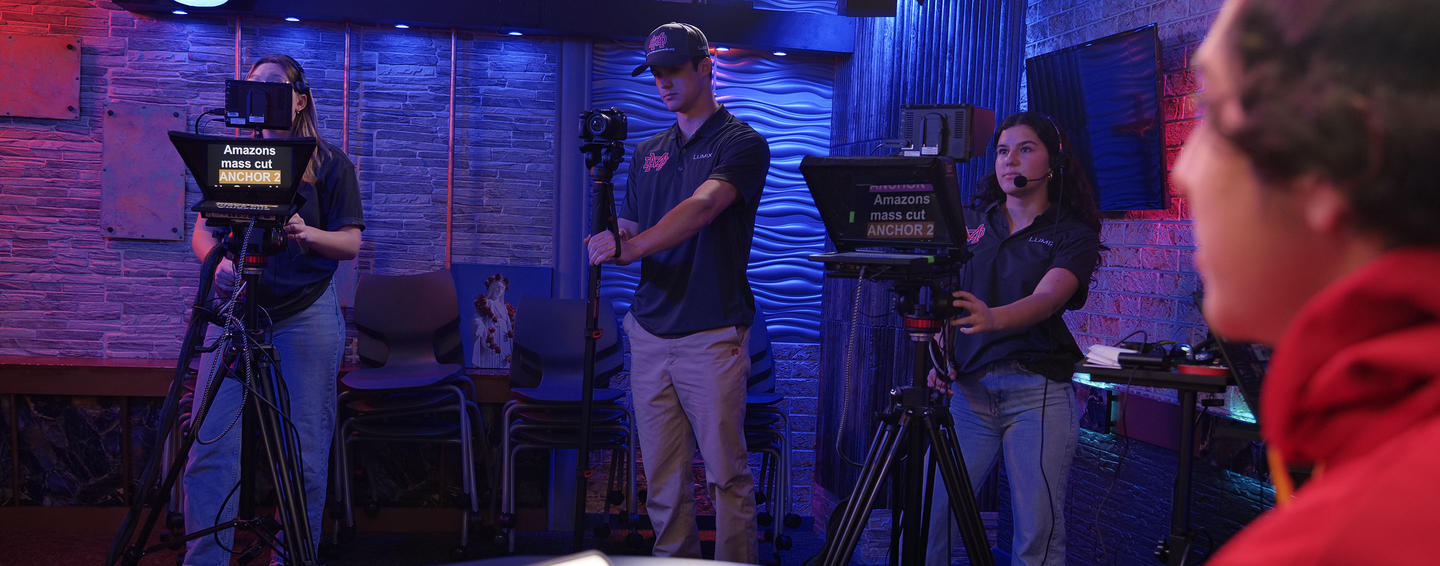
Creating a Film & Media Arts Program With LUMIX
California's Mater Dei High School implements LUMIX cameras into its curriculum
With the rise of streaming channels, video sharing sites, and social media influencers, there’s never been such a demand for content creators. As a result, forward thinking K – 12 schools are starting advanced programs to prepare students for film and media - whether it’s for college study, or jobs in the film and broadcast industry.
Founded in 1950, Mater Dei High School is a private, Catholic, co-educational secondary school in Santa Ana, California. With over 2,200 students, Mater Dei is perhaps best known for its sports programs, especially its nationally top ranked Monarchs football team. (Several of its alumni have won the Heisman Trophy, including former NFL quarterback Matt Leinart and future NFL draft pick Bryce Young.) The school is now putting greater focus on its arts program, which looks to match its sports programs by building a new performing arts center, concentrating on theater, choir, music, instrumental music, and the film and television program.
The Mater Dei Film & Media Arts program is headed by Andrew Roberts, who joined Mater Dei in 2016. A thirty year veteran of the entertainment industry, Roberts has worked in all aspects of entertainment, including theater, concerts, comedy, and dance performances. In the mid 2000s, he moved into grip work, which eventually brought him to cameras.
As the director of the program, Roberts has focused on growing the advanced television production classes and writing curriculum for the program. When first joining Mater Dei, Roberts was not a LUMIX user but had the opportunity to borrow a GH5 from the school’s marketing program. “I do a lot of personal photography on my own,” explained Roberts. “I said to the department chair, ‘Hey, I'm going away to the mountains this weekend, can I borrow this?’ By the end of the day Saturday, I knew that I needed to get a LUMIX of my own. We went from a department of one LUMIX to now exclusively using LUMIX cameras.” Roberts currently shoots with his own LUMIX S5 and S1H for photography and film projects.
Mater Dei Film & Media Program Director Andrew Roberts
The Curriculum
Roberts based his curriculum on the California Educational Standards for technology, which has an entire grouping of curriculum based around film and television production. “Our goal is to get cameras in the hands of students immediately,” said Roberts. “We want them to learn hands on because you can't learn filmmaking and television production through lecture, books, or YouTube videos. You have to have the cameras in your hands.”
The curriculum includes everything from the basics of composition to technical proficiency in post-production. They have introductory, mid-level, and advanced classes with a goal to build each class to the next level, establishing integral student outcomes (ISOs). “It could be something as simple as, ‘How do you turn on a camera?’” said Roberts, “or how do you frame a static or moving subject. You start out with a game plan, and you just work through it. Each lesson has its own basic set of curriculum that will continue to build onto itself. In theory, if I were to leave here, a new teacher could walk in, open up my curriculum for every class and have a guideline, which is really what a big part of the curriculum is. It’s a roadmap to get our students into the outcomes that we're looking for.”
By the end of the first semester, all of the students, regardless of their class level, are checking out cameras and shooting their final projects in small groups with changing roles. The program’s main goal is to have a consistent benchmark for competency with the gear, as well as proper technique.
The program also produces a number of multicam live broadcast events, including performing arts (musicals, theatre, dance), sports (basketball, volleyball, lacrosse), and graduation, which will stream through YouTube Live on the school's website.
Student lining up a shot for an event in Mater Dei High School's gymnasium.
LUMIX Implementation
Mater Dei Film & Media Arts students use three LUMIX BGH1s on rails (a motorized camera sled) and sticks (aka tripods) in their studio where they produce a daily morning show. They use a mixture of roughly 20 G95, GH5, and GH6 cameras on gimbals, sticks, and handheld in order to create a multitude of film and television projects. The introductory classes use the LUMIX cameras to meet a benchmark by producing several large PSAs for Red Ribbon Week, which air to the entire school at the end of October. “Before joining our program, many students have only shot with their phones, or iPads,” Roberts revealed. “Now you put a camera in their hands, and they have so much more control visually. It raises their expectations of what they themselves can produce.”
The students start with the basics – from inserting batteries into cameras to learning about the different modes to shoot in and which modes work best for different scenarios to the exposure triangle (aperture, shutter speed, ISO). For film projects, they shoot everything in 4K/23.98-fps but for their studio show they record in FHD at 59.94. With multi-year students, Roberts enjoys seeing the progress in camera proficiency. “Without a doubt, one of the best parts about teaching with LUMIX cameras in particular, is watching from the beginning these early compositional and technical techniques and then seeing a student’s evolution semester-to-semester, and then year-to-year.
Mater Dei students shooting a two-camera segment out in the field. Roberts feels it's important to get cameras into students' hands immediately.
Why LUMIX
According to Roberts, his students love LUMIX’s color science and sharpness, especially when compared to other camera systems. When they first encounter the BGH1s on rails, getting them accustomed to a broadcast style camera with a teleprompter is less intimidating since the menus are similar to other LUMIX cameras. “It's really easy to integrate different LUMIX cameras,” Roberts explained, “and there’s no learning curve to get them competent at learning a different system. LUMIX camera controls are so intuitive that we move immediately into manual mode.”
One LUMIX feature that Mater Dei students love is the cameras’ in body image stabilization (IBIS), or Dual IS when using certain LUMIX lenses. “Some of the students in the beginning are intimidated by gimbals (handheld motorized camera stabilizers),” said Roberts. “They're impatient with the setup, or if they forget that I changed the zoom when I balanced it, it's not going to work properly. So having that in body image stabilization to get them used to shooting handheld and how they can mock a Steadicam, gimbal, or slider shot is just amazing. You pair that with a lens that has image stabilization and you’re even increasing it. That is definitely one of the biggest features that we use.
When speaking with other schools that are looking to start their own programs, one of the things Roberts explains to them is the value factor of cameras like the LUMIX G95. “You’re not going to touch another camera system in terms of image quality and features,” he explained. “Oftentimes it’s a misnomer that when people are building a program, they need to have these big flashy cameras on sticks or pedestals.”
According to Roberts, getting students accustomed to to a broadcast style BGH1 box camera with a teleprompter is less intimidating since the menus are similar to other LUMIX cameras.
Growing The Program
Since 2016, Roberts has seen tremendous growth in his program, starting with eight students in 2016 to now 56 students with a waiting list. He’s witnessed a greater number of students pursuing college programs and career paths in film, news, sports content creation, and television production. According to Roberts, students will often use his curriculum for different classes, or disciplines. “For example, a student might be in a biology class, and they'll use our studio and gear to create a fake sit down news program, or a piece about cell regeneration with talking heads. A lot of internal and personal creation is coming out of the things they learn in our program.”
Mater Dei has recently launched a social media content creation class that utilizes the students filmmaking and broadcast skills to quickly produce and distribute content. Due to the school's strong sports program, many students in the program have collaborated with student athletes in creating dynamic sizzle reels for recruitment to major college and universities. According to Roberts, this has helped build a better community within the student body.
Roberts has seen growth in his program, starting with eight students in 2016 to now 56 students with a waiting list.
Many of Mater Dei Film & Media Arts students have gone on to study film, journalism, and broadcasting at university, including The Walter Cronkite School of Journalism at Arizona State, UCLA, Boston College, Cal State Fullerton, and more. “I have a student, who is working with Specialized Bicycles and he's looking to integrate his film and video experience into that,” said Roberts. “I've had students whose parents are high-end real estate agents, and they've been able to take the curriculum that we've taught them and become video guides for homes on either gimbals, or drones.
“Because we are primarily known as an athletic school,” continues Roberts, “the joke is sometimes that we are a feeder school for USC, since we send a lot of our athletes to their sports programs. My goal is to be able to do that in the film and media world.”
For more information about Mater Dei's Film & Media Arts Program, click through here.
